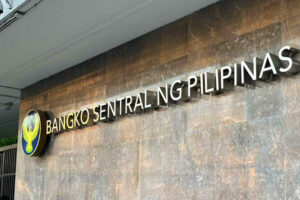EASING INFLATION will allow the Bangko Sentral ng Pilipinas (BSP) to slash benchmark borrowing costs further this year to support a slowing economy, Fitch Solutions’ unit BMI said.
“We expect the Bangko Sentral ng Pilipinas to maintain a pro-growth policy stance in the second half of 2025 amid growing economic uncertainty,” BMI said in an Aug. 20 note.
“Against this backdrop, we expect the BSP to cut its policy rate by a further 50 bps (basis points) to 4.75% by end-2025.”
Philippine gross domestic product (GDP) grew by 5.5% in the second quarter, slightly faster than the 5.4% print in the first quarter.
For the first half, GDP expansion averaged 5.4%, slower than the 6.2% a year ago. This is a tad below the government’s 5.5-6.5% growth target for the year.
“We believe this underperformance will continue into the coming quarters, given mounting signs of softening domestic activity and the winding down of exports frontloading,” BMI said.
The Philippines’ trade-in-goods deficit narrowed to $3.95 billion in June as exports jumped by 26.1% to $7.02 billion, driven by frontloading in anticipation of higher US tariffs.
For the first semester, the trade gap narrowed to $23.97 billion from the $25.06-billion deficit a year ago.
BMI said the BSP has the policy room to continue its easing cycle as inflation remains benign. Headline inflation eased to a near six-year low of 0.9% in July, which brought the seven-month average of 1.7%, slightly higher than the BSP’s 1.6% forecast for the year but below its 2-4% annual target.
“With geopolitical risks, particularly surrounding the Israel-Iran conflict, now largely de-escalated, energy-related price pressures are expected to remain contained,” BMI said.
It added that it now expects inflation to average just 1.6% this year, down from its previous forecast of 2.2%.
The BSP has lowered benchmark interest rates by a cumulative 125 bps since August 2024, with the policy rate now at 5.25%.
BSP Governor Eli M. Remolona, Jr. earlier said that another rate cut is “quite likely” at the Monetary Board’s Aug. 28 meeting, adding that the central bank could deliver only two more reductions this year, including the one they could implement next week.
After the Aug. 28 review, the Monetary Board’s remaining meetings for this year are scheduled for Oct. 9 and Dec. 11.
BMI’s forecasts showed that it also expects another 25-bp cut in 2026 that would bring the policy rate to 4.5%. It sees the BSP bringing down its benchmark rate to 3.5% by 2027 to mark the end of its current easing cycle, backed by its expectation that the consumer price index will remain within the 2-4% target in the next two years.
“Despite rate cuts by the BSP, the peso will strengthen slightly from current levels as the evolving situation in the US weighs on the dollar,” BMI added.
It expects the peso to trade from P55.20 to P59.20 against the dollar this semester. supported by a healthy interest rate differential between the US and the Philippines as the Federal Reserve is also expected to cut its own target rate by 50 bps in the second half.
The Fed has kept its target rate at the 4.25%-4.5% range since December 2024. Markets widely expect the US central bank to bring down benchmark borrowing costs next month.
“The Fed is facing growing political pressure from President Donald J. Trump, who has publicly and repeatedly called for looser monetary policy. In turn, markets could interpret any rate cuts as politically driven, raising doubts about the Fed’s independence especially if rate cuts coincide with fiscal slippage or policy uncertainty,” it said.
“This would support risk appetite for EM (emerging market) currencies such as the peso.”
On Wednesday, the peso closed at P56.96 versus the dollar, climbing by 14 centavos from Tuesday’s finish of P57.10.
Year to date, the local unit is up by 1.55% from its end-2024 close of P57.845. — BVR

